Physical Address
304 North Cardinal St.
Dorchester Center, MA 02124
On completion of this chapter, you should be able to:
Discuss the sonographic approach to imaging neonatal/pediatric kidneys and adrenal glands
Distinguish normal anatomy and sonographic findings from abnormal findings
List and discuss the pathologic conditions covered in this chapter
Sonography is the diagnostic imaging method of choice when a renal or an adrenal abnormality is suspected in the neonate or pediatric patient. While there are numerous indications for this examination during the newborn period, an abnormality detected during prenatal sonography (such as urinary tract dilation [UTD] or a two-vessel umbilical cord) is common. Other conditions or findings in the newborn associated with renal abnormalities are anuria, oliguria, hematuria, urinary tract infection (UTI) or sepsis, ambiguous external genitalia, and prune-belly syndrome. Skin tags found near the ear and associated cardiac anomalies may also be an indicator. Additionally, a palpable flank mass or abdominal distention may be concerning. Renal masses make up about 70% of abdominal masses in neonates, and nearly all are asymptomatic. Flank masses in neonates may also arise from the adrenal glands, although less often. These conditions usually indicate the renal study is for screening the kidneys with no particular renal symptoms present.
In the older infant and child, indications often include screening for known congenital anomalies or acquired conditions presenting with symptoms, such as flank pain and hematuria.
The urinary bladder is considered an important part of the renal sonographic examination, and therefore any child who has bladder control should come to the examination with a full bladder. Full bladder preparation recommendations, along with general aspects of scanning the neonate and pediatric patient, are described in Chapter 25 . Keep in mind that maintaining the body temperature is important in the preemie and neonate.
A 10-MHz curved array (slightly more curved than an adult footprint) is ideal for scanning neonates and infants, whereas a 7.5-MHz transducer with a similar footprint can provide excellent visualization in a young or thin child. A 3- to 6-MHz curved array is typical for an older child or adolescent. Additionally, a 9- to 12-MHz linear array will provide better detail resolution when imaging premature infants, scanning from the prone position, or when pathology is suspected.
Scanning is gently initiated over the suprapubic region due to the infant’s tendency to urinate spontaneously and a young child’s inability to hold the bladder for extended periods. If the urinary bladder is not distended at the time, or if voiding occurs before adequate detail can be obtained, the pelvis can be reexamined after imaging the kidneys and retroperitoneum, documenting the aorta, inferior vena cava, and adrenal glands or area superior to the kidneys. Filling of the urinary bladder is relatively rapid if the infant is fed or parenteral fluids are being administered. A pre-void bladder volume and bladder wall thickness measurement should be obtained with a full bladder.
Next, longitudinal and transverse views of the kidneys are documented in the supine or decubitus position. Renal measurements and volumes should be obtained, as well as documentation of the renal echogenicity compared with the liver and spleen. In the infant and young child (or when feasible), dedicated renal views are obtained by scanning the patient’s back from the prone position with a linear transducer. It should be noted the renal length may be slightly shorter from this position, and prone-dependent renal dilation may occur.
In the toilet-trained or older child, the patient is then instructed to urinate fully. The bladder is reexamined in longitudinal and transverse views, including a post-void bladder volume and bladder wall measurement.
In the setting of urinary tract dilation (UTD), an anterior-posterior measurement of any dilated renal pelvis or ureter should be obtained. Furthermore, supine renal scanning before and after the infant or child voids can provide useful information. When imaging an infant or a child who needs to urinate before instructed to do so, it is ideal to document the kidneys while the bladder is still full. One sagittal and one mid-pole transverse image will often suffice to detect fluid in the kidneys. Likewise, similar post-void images of the kidneys should be obtained in an older child if any UTD was seen throughout the examination.
The sonographic appearance of the kidneys varies, depending on the age of the child. This is especially apparent in the young infant. Keep in mind, premature infants are adjusted to their gestational age until they are 2 years old. (For example, a 5-month-old, born 2 months early, would be evaluated as a 3-month-old.) In the second trimester, the kidneys grow from small renunculi that are composed of a central large pyramid, with a thin peripheral rim of the cortex. As these renunculi fuse progressively, their adjoining cortices form the columns of Bertin. The former renunculi are then called lobes . Remnants of these lobes, with somewhat incomplete fusion, are termed fetal or renal lobulation and should not be confused with renal abnormalities or scars. Renal lobulation is most prominent at birth and in the neonatal period, often disappearing completely by 6 years of age. Even after birth, the pyramids remain large compared to the thin rim of the cortex that surrounds them. The glomerular filtration rate is low right after birth but increases rapidly thereafter. The cortex continues to grow throughout childhood, whereas the pyramids become smaller. The sinus fat often seen in adults is not present in the neonate and is rarely observed in the pediatric patient.
The normal kidney in the neonate and infant is characterized by a distinct demarcation of the cortex and medullary pyramids, or corticomedullary differentiation , owing to a larger medullary volume. The medullary pyramids are prominent and hypoechoic and should not be mistaken for dilated calyces or cysts. They are typically less prominent by 1 year of age. The surrounding cortex is quite thin at birth, and echogenicity varies by age.
Premature infants tend to have more echogenic kidneys, owing to underdevelopment of the renal structures. Echogenicity in the full-term neonate may be similar to, or slightly greater than, the normal liver and splenic parenchyma. This increased cortical echogenicity is only seen in the neonatal period, up to 1 month of age ( Fig. 26.1 ). Renal cortical echogenicity normally decreases to less than the liver parenchyma by 4 to 6 months.
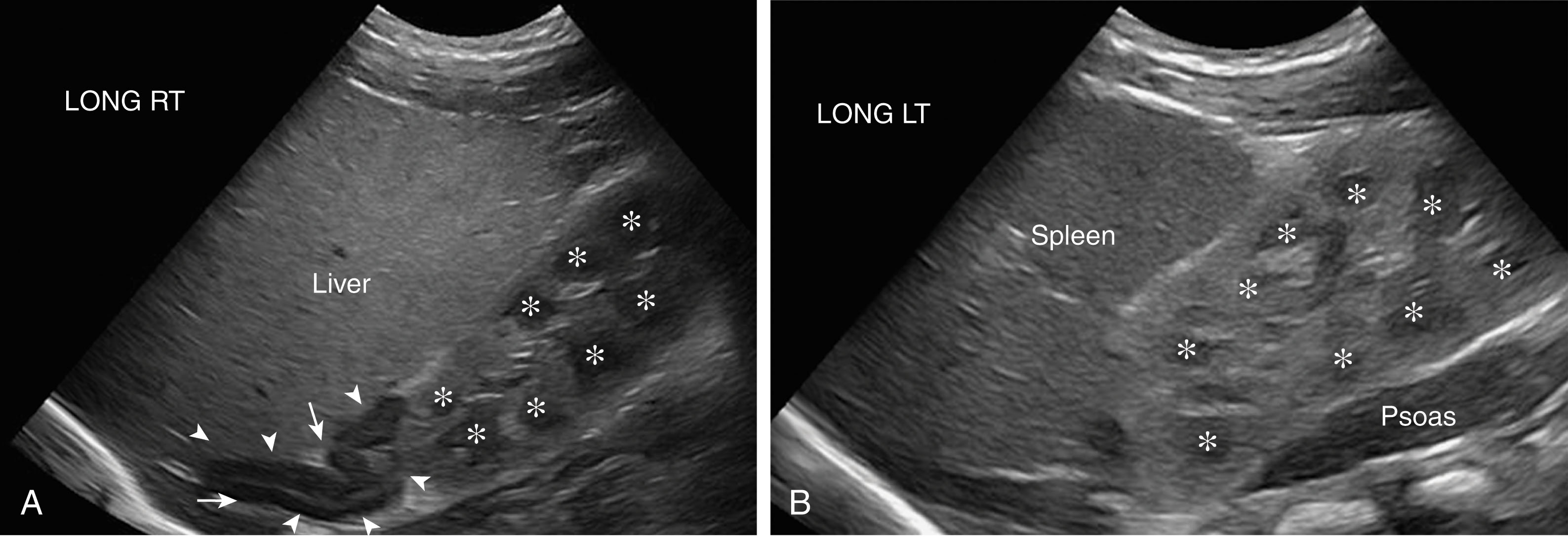
The increased cortical echogenicity may result from the glomeruli occupying a larger proportion of cortical volume and the location of the loops of Henle within the cortex (20% versus 9% in adults) as opposed to within the medulla. Due to a paucity of fat in the renal sinus of the neonate and infant, this area is generally hypoechoic and therefore indistinct.
The sonographic renal anatomy in children and adolescents is similar to an adult. The normal cortex is thick and produces low-level, back-scattered echoes. The medullary pyramids are relatively hypoechoic and arranged around the central, echo-producing renal sinus ( Fig. 26.2 ).
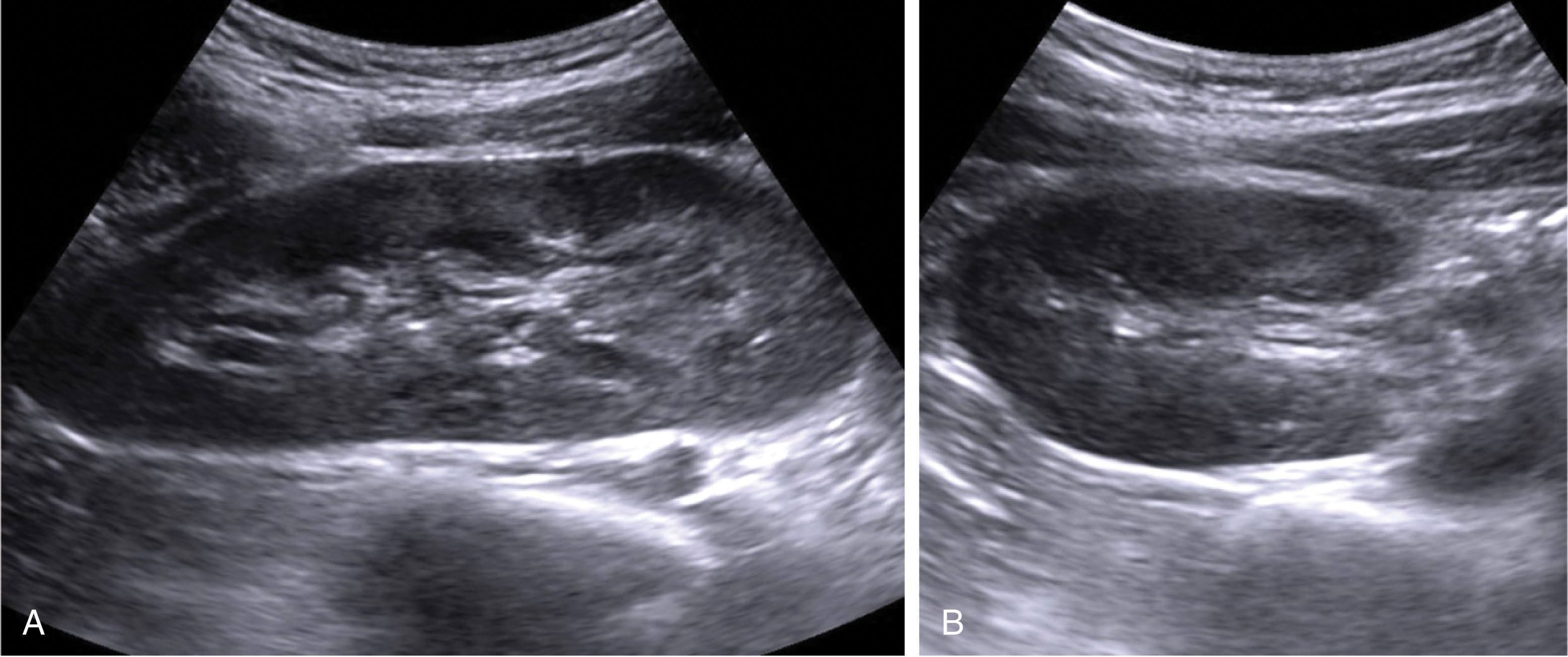
The arcuate artery vessels may be seen as intense specular echoes at the corticomedullary junction. Color Doppler is often used to document the renal artery and vein in the pediatric renal examination and is best taken in a mid-transverse view. This also aids in differentiating a prominent vein from dilation in the renal pelvis.
Pulsed Doppler can detect cases of renal vein thrombosis, hypertension, or other suspected vascular diseases. A dedicated renal duplex examination reports the direct methods of the peak systolic velocities of the renal artery and aorta. The peak systolic velocity of the renal artery should be less than 180 cm/sec, and the RAR (renal artery and abdominal aorta ratio) less than 3.5:1. Indirect methods include sampling the segmental, or arcuate arteries, and measuring the resistive index (RI) and acceleration time (same criteria as in adults, less than 70 msec) in the superior, mid, and inferior poles. The normal RI value varies greatly within the first year: preterm infant, up to 0.9; neonate, 0.6 to 0.8; and by the end of the first year show values similar to those found in adults, 0.5 to 0.7. It is important to keep in mind that cardiac disease, coarctation of the aorta, and patent ductus arteriosus may also affect the RI.
The normal renal length varies with the age of the neonate or pediatric patient ( Fig. 26.3 ). Accurate and consistent measurements are important to document normal growth and to help detect abnormalities. Although the left kidney is often somewhat longer, a kidney measurement greater than 1 cm side to side should be monitored closely; and may indicate infection, scarring, or congenital abnormalities, such as hypotrophy or a duplex collecting system.
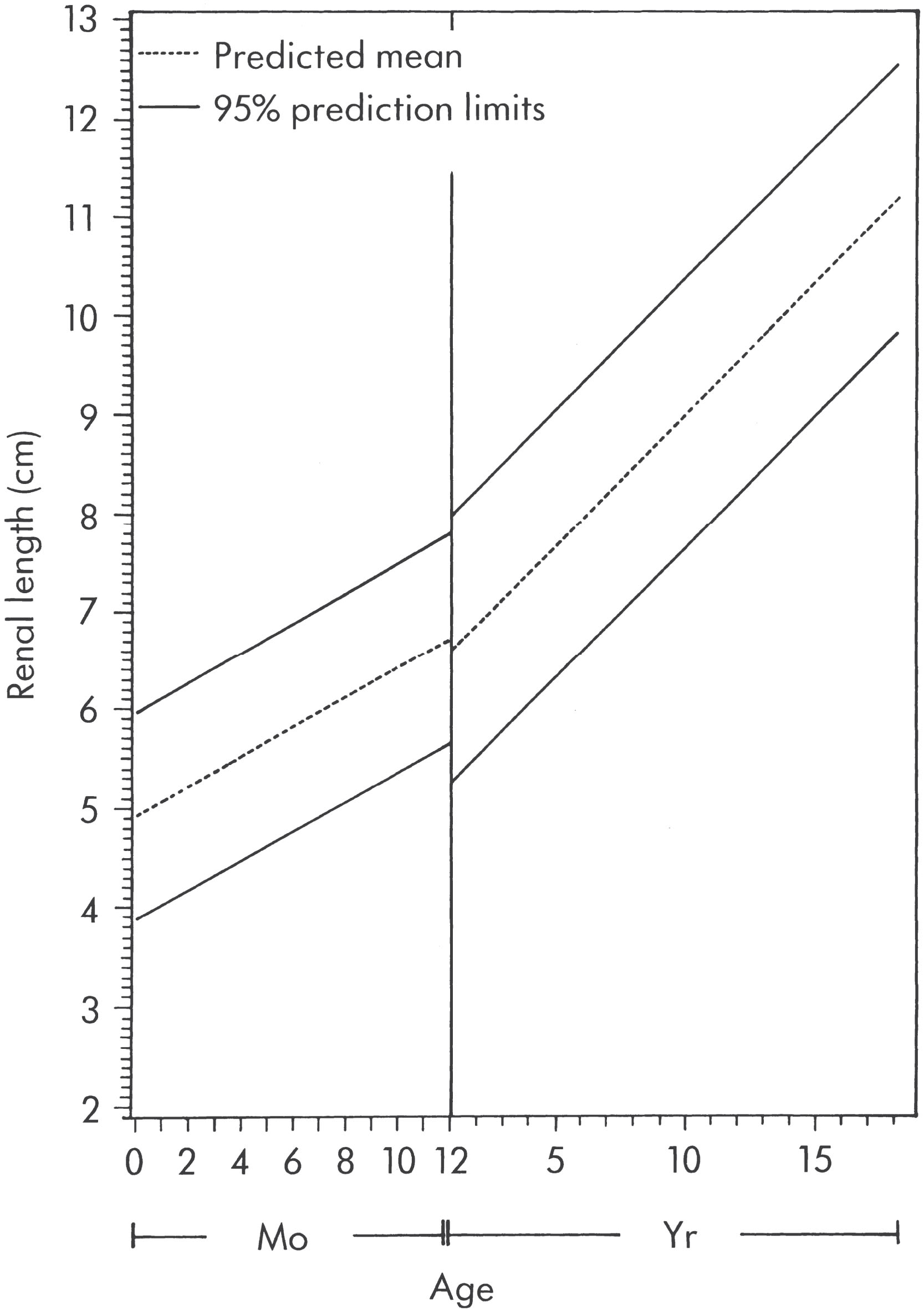
The normal adrenal glands are larger and more easily identified in the neonate than in the older infant or young child. In fact, the prominent size of the adrenal gland at birth will normally decrease rapidly within the first 10 days and then slowly atrophy over the next few weeks. At 1 year of age, it takes on the appearance of an adult adrenal gland. Each gland lies immediately superior to the upper pole of the kidney. The left adrenal gland extends slightly more medial than the right. The gland has an inverted V or Y shape in the longitudinal plane ( Fig. 26.4 ). In the transverse plane, the portion of the gland delineated has a linear or curvilinear outline. When the kidney is absent or ectopic, the ipsilateral adrenal gland remains in the renal fossa, but as a result, it may have an altered elongated “lying down” configuration. Sonographically, the central adrenal medulla in the neonate is relatively thin, appearing as a distinctly echogenic stripe, surrounded by the more prominent and less echogenic adrenal cortex ( Fig. 26.5 ).
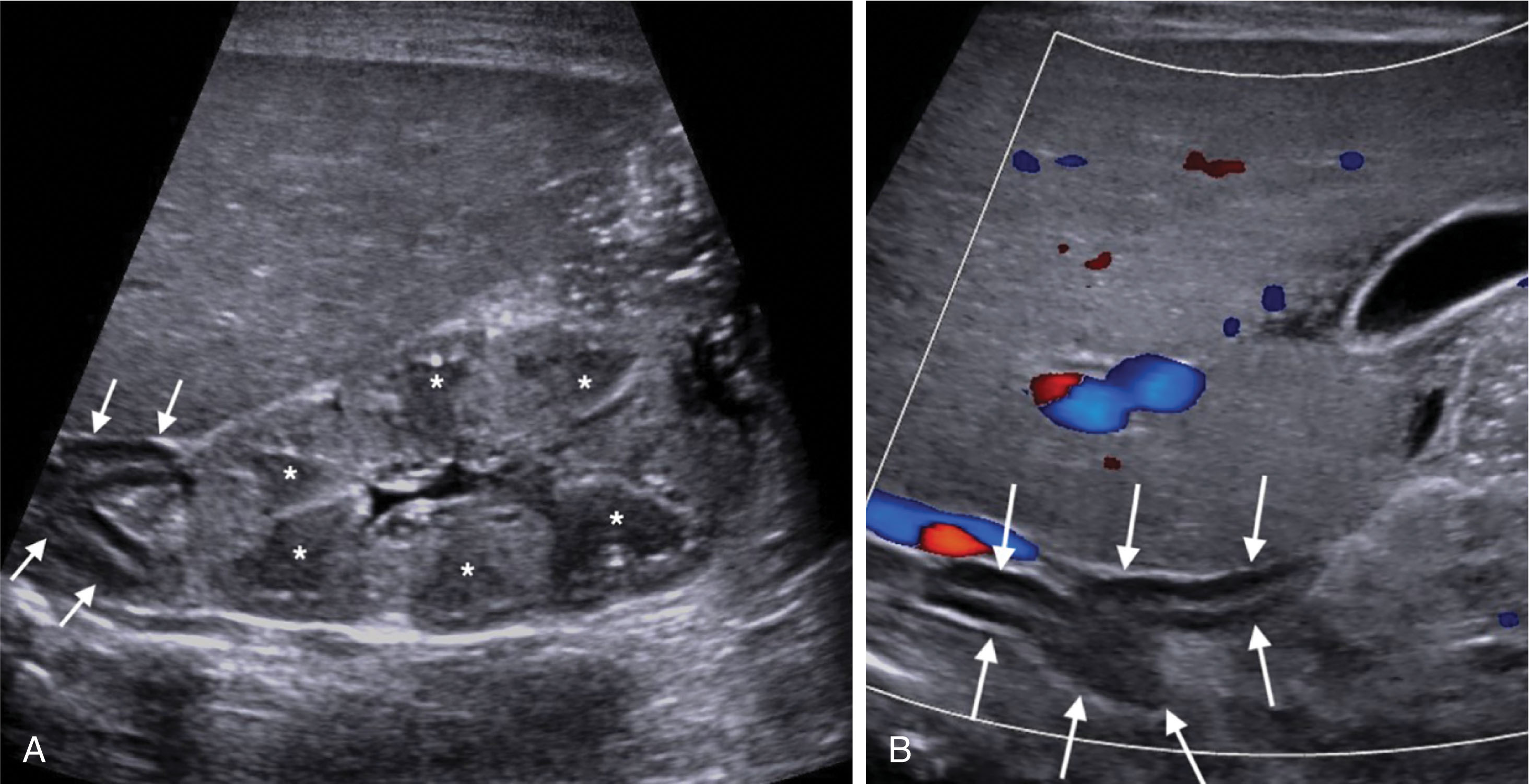
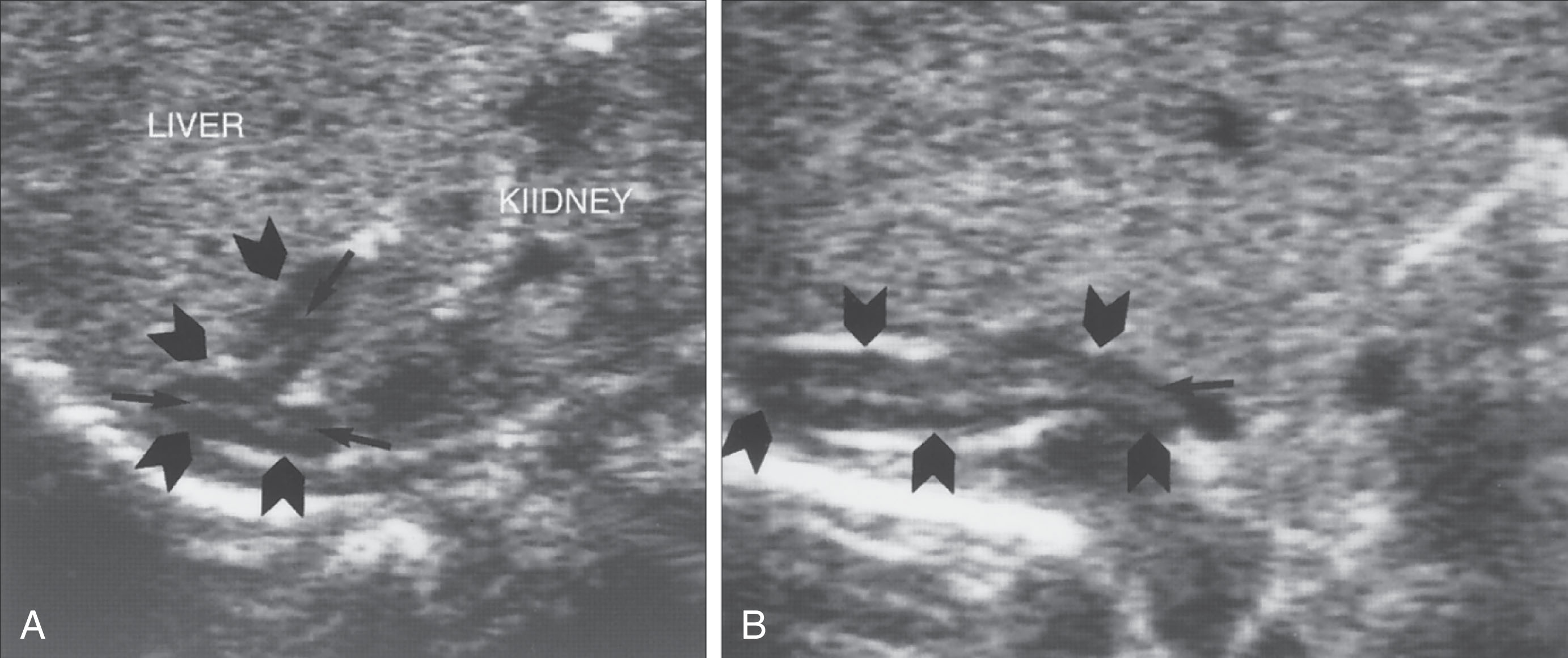
The normal urinary bladder is thin-walled in the distended state and should measure less than 3 mm (mean, 1.5 mm) in the anterior-posterior (AP) dimension. When empty, the wall thickness increases but remains less than 5 mm. In pediatrics, the anterior bladder wall may be difficult to accurately measure due to excessive ring-down artifact and the prominent urachal remnant sometimes seen in children. Therefore, the posterior bladder wall is measured, and the posterolateral wall has been suggested to avoid the thickened posterior region of the trigone, which has different characteristics than the detrusor muscle. The bladder should normally empty completely or at least 90% of the bladder capacity. An exception is made for infants, as they often retain urine in their bladder ( Fig. 26.6 ). Visualization of the bladder also includes the assessment for distal ureteral dilation. Color Doppler aids in depicting the normal distal ureteral jets as they enter the posterior wall of the bladder.
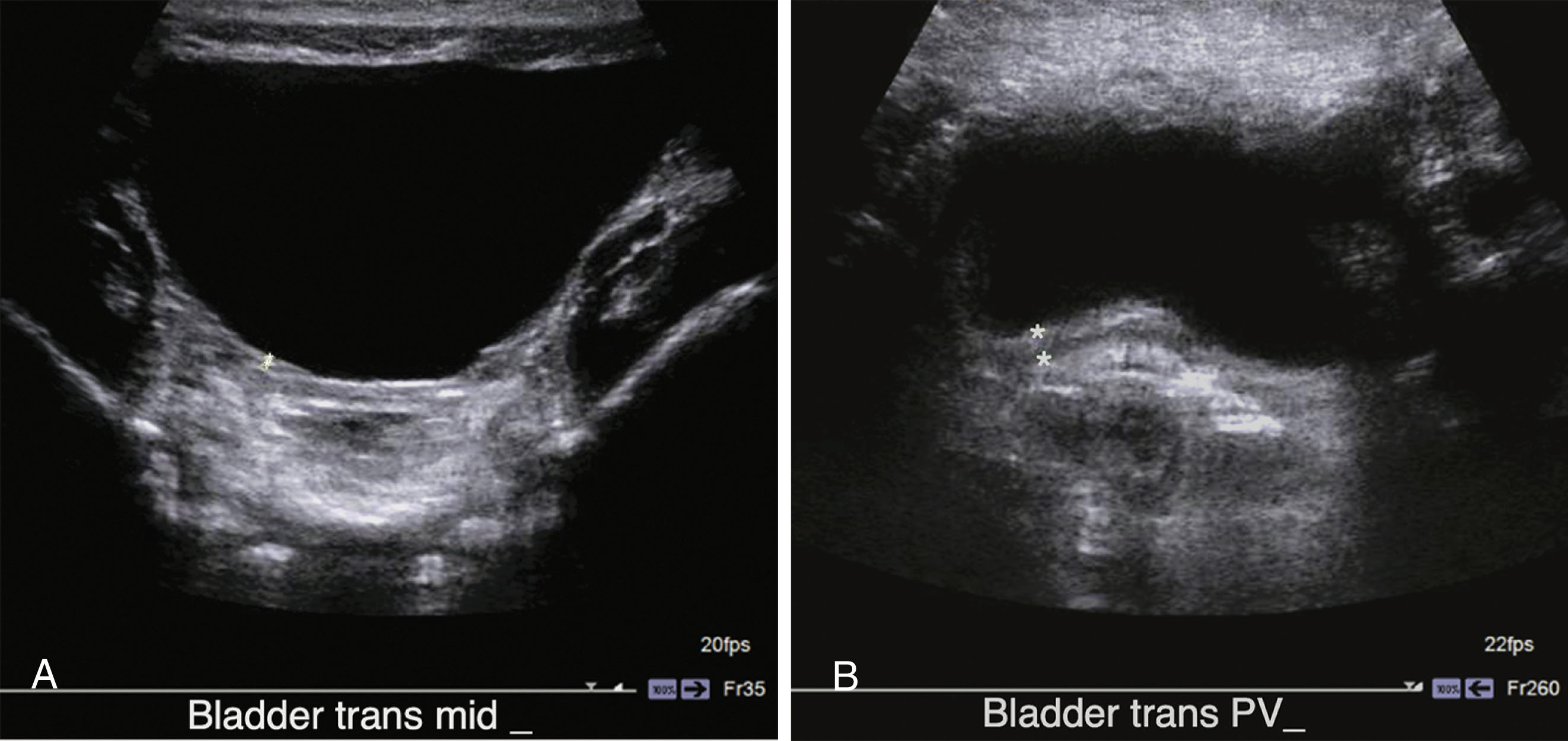
The use of contrast in the pediatric population has elevated the role of sonography from a screening examination to a critical tool in disease diagnosis and monitoring. Contrast-enhanced ultrasound (CEUS) detects blood perfusion abnormalities in real-time with the use of intravascular microbubble agents. Due to different vascularization patterns of benign and malignant lesions, tumors may be evaluated with CEUS to exclude malignancy, with immediate results. This obviates the need for further testing and reduces stress for both parents and children alike. Furthermore, if a biopsy is found to be necessary, CEUS can detect areas of viable tumor versus areas of necrosis, reducing false-negative results.
Contrast-enhanced voiding urosonography (ceVUS) administers these same microbubble agents via a urinary catheter to sonographically evaluate for vesicoureteral reflux. The higher sensitivity of ceVUS, coupled with a detailed evaluation of the urethra, provides a safe and radiation-free alternative to the voiding cystourethrogram ( Fig. 26.7 ).
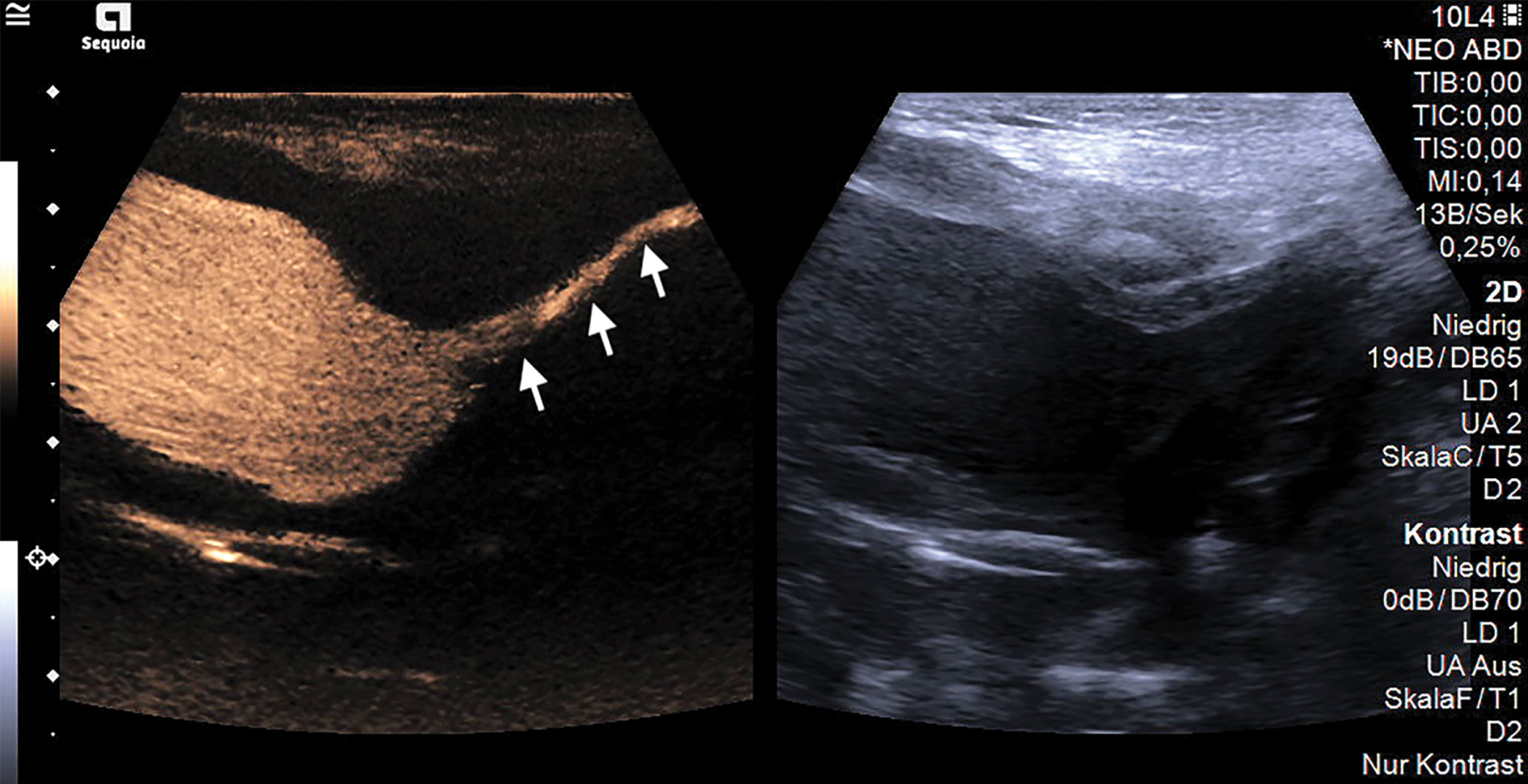
Congenital anomalies, hereditary renal cystic disease, acquired pathologies, and malignant tumors of the neonatal and pediatric urinary tract and adrenals are presented here. Although discussed separately, it should be understood congenital or genetic abnormities might contribute to an increased risk of acquired or malignant processes.
The pathologies discussed, underlying benign renal and adrenal enlargement, are summarized in Table 26.1 , while malignant tumor findings are provided in Table 26.2 . Furthermore, abnormalities in the urinary tract can often be related to abnormities of the reproductive system, hence the genitourinary system. When renal abnormalities are detected, a pelvic ultrasound exam may be subsequently ordered, and keeping the bladder full may be prudent ( Fig. 26.8 ).
| Clinical Findings | Sonographic Findings | Differential Considerations |
|---|---|---|
| UTD (Hydronephrosis) | ||
| Flank pain |
|
|
| Duplex Collecting System (With Ectopic Ureterocele) | ||
| Recurrent urinary tract infection |
|
Renal cyst in superior pole with vesicoureteral obstruction due to a ureterocele |
| Posterior Urethral Valves | ||
| Decreased urine output |
|
Pelvic mass or tumorBilateral megaureters |
| Multicystic Dysplastic Kidney | ||
|
UTD | |
| Autosomal Recessive Polycystic Renal Disease | ||
|
|
|
| Prune-Belly Syndrome | ||
|
|
Posterior urethral valves |
| Congenital Mesoblastic Nephroma | ||
| Found in children <1 year of age | Hyperechoic or hypoechoic or mixed |
|
| Adrenal Hemorrhage | ||
|
|
|
| Clinical Findings | Sonographic Findings | Differential Considerations |
|---|---|---|
| Neuroblastoma | ||
|
|
|
| Wilms Tumor | ||
|
|
|
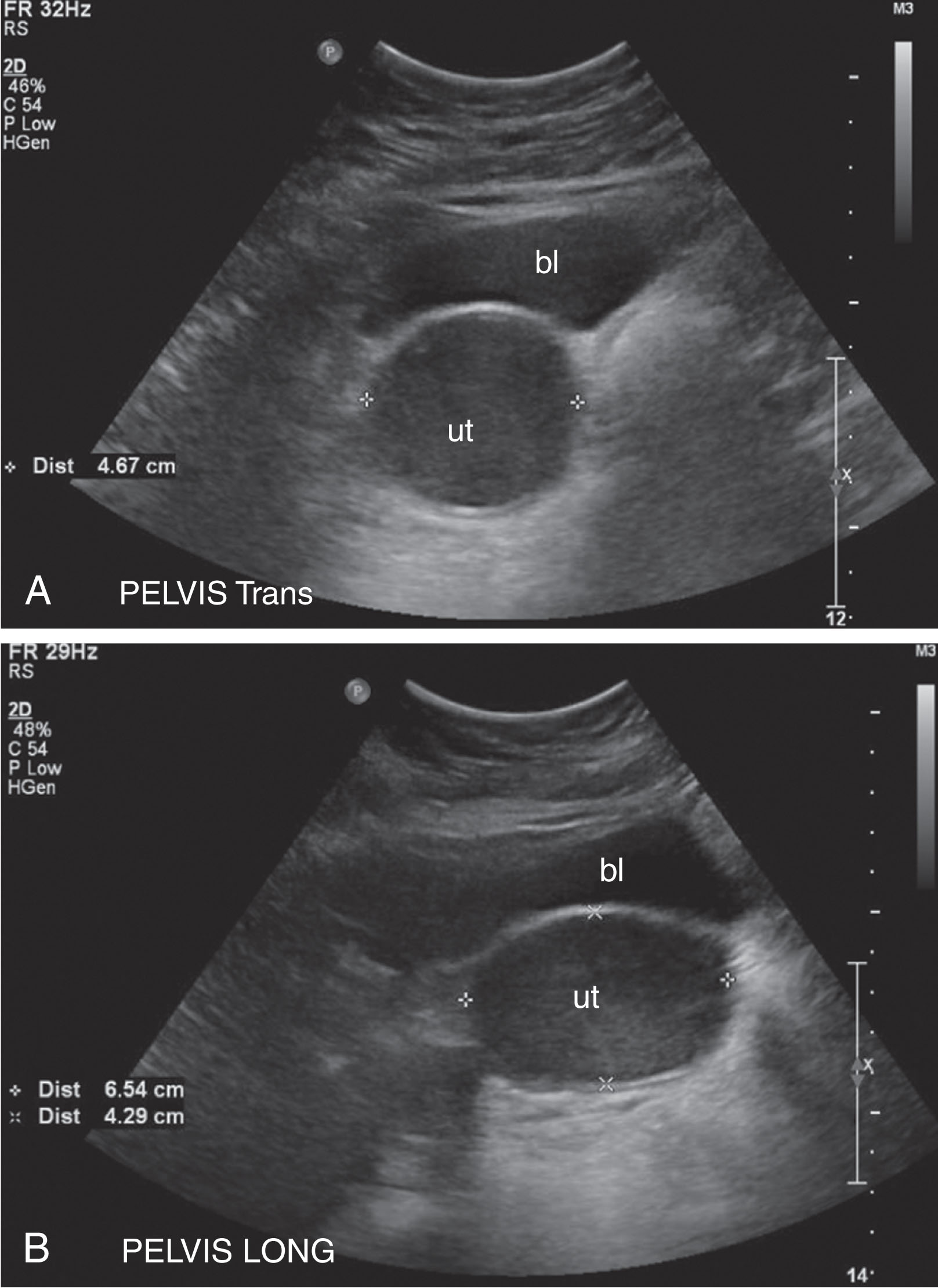
Pediatric sonography plays a vital role in the detection of congenital urinary tract anomalies, which account for half of all congenital anomalies and occur in 3% to 11% of the general population. These anomalies may be isolated, exist in tandem, or occur as part of the VACTERL association (vertebral defects, anal atresia, cardiac defects, tracheoesophageal fistula, renal anomalies, and limb abnormalities). Abnormalities of the collecting system are the most common and are the primary focus of this section. The multicystic dysplastic kidney, crossed-fused renal ectopia, and patent urachus are presented here. The reader is referred to Chapter 15 for further discussion on other anomalies that may be encountered, such as abnormal renal number (renal agenesis and supernumerary kidney) and anomalies related to renal position (ectopic kidney) and renal form (horseshoe kidney).
Dilation of the urinary tract has many causes, and sonography allows for the detection and differentiation of the many possible underlying conditions. UTD, also known as hydronephrosis, describes the dilation of the urinary collecting system. It is also the most common cause of a palpable mass in the neonate, accounting for 50% of congenital malformations. The most common causes of UTD are obstruction, reflux, or abnormal muscle development. Since the urine is made in the kidneys, dilation will occur proximal to any obstruction. Sonography is sensitive in detecting small amounts of fluid in the renal pelvis. The sonographer is able to determine the severity of the UTD, whether the condition is unilateral or bilateral, if the ureters and bladder are dilated, and the status of the renal parenchyma.
Sonographic features found in UTD include visible renal parenchyma surrounding a central cystic component, small peripheral cysts (dilated calyces) budding off a large central cyst (renal pelvis), and visualization of a dilated ureter. Renal dilation must be distinguished from the noncommunicating cysts of multicystic dysplastic kidneys.
Commonly referred to as hydronephrosis, the degree of dilation within the urinary tract has not been uniformly classified over the years. Classification systems include the Society for Fetal Urology grading system (SFU grades I-IV), the radiology grading system (RAD I-V), as well as the updated Onen system (ONEN grades I-IV). In each of these systems, a renal pelvis dilation is normal up to 10 mm in the AP dimension. However, common terminology and classification were needed to define abnormal dilation.
Recently, a multidisciplinary consensus on terminology and classification for UTD was created to unify the prenatal and postnatal language around urinary tract findings. Previously, various terms for UTD were nonspecific and had only implied meanings; common terms relating to UTD include hydronephrosis, pyelectasis, pelviectasis , and pelvic fullness . Additionally, calyceal descriptors, such as the term major calyces to describe the centrally located calyces and the term minor calyces used to describe the peripherally located calyces, should also be avoided. The use of these more confusing terms is discouraged, and UTD is preferred. However, while the UTD terminology is being adopted, the use of the term urinary tract dilation (UTD) is used in place of the word hydronephrosis throughout this text.
Unified language around this prevalent pathology will allow for clearer communication among clinicians and improve research outcomes. The full postnatal UTD classification system is provided in Table 26.3 . The system uses six ultrasound findings to classify and describe both antenatal and postnatal UTD. Both prenatal and antenatal classifications include normal, UTD 1, UTD 2 , and UTD 3 . The postnatal findings would be termed UTD P1 , whereas the antenatal equivalent would be termed UTD A1 . The antenatal findings are used after 16 weeks gestation, while the first postnatal evaluation should occur 48 hours after birth. The diagnosis is more severe as the number increases, with UTD 3 being the most critical. The UTD classification system is based on the following criteria:
Measurement of the greatest AP distention within the dilated renal pelvis (intrarenal) in the transverse view. It is recommended this measurement be taken with the patient in the prone position . It is called the AP renal pelvic diameter ( Fig. 26.9 )
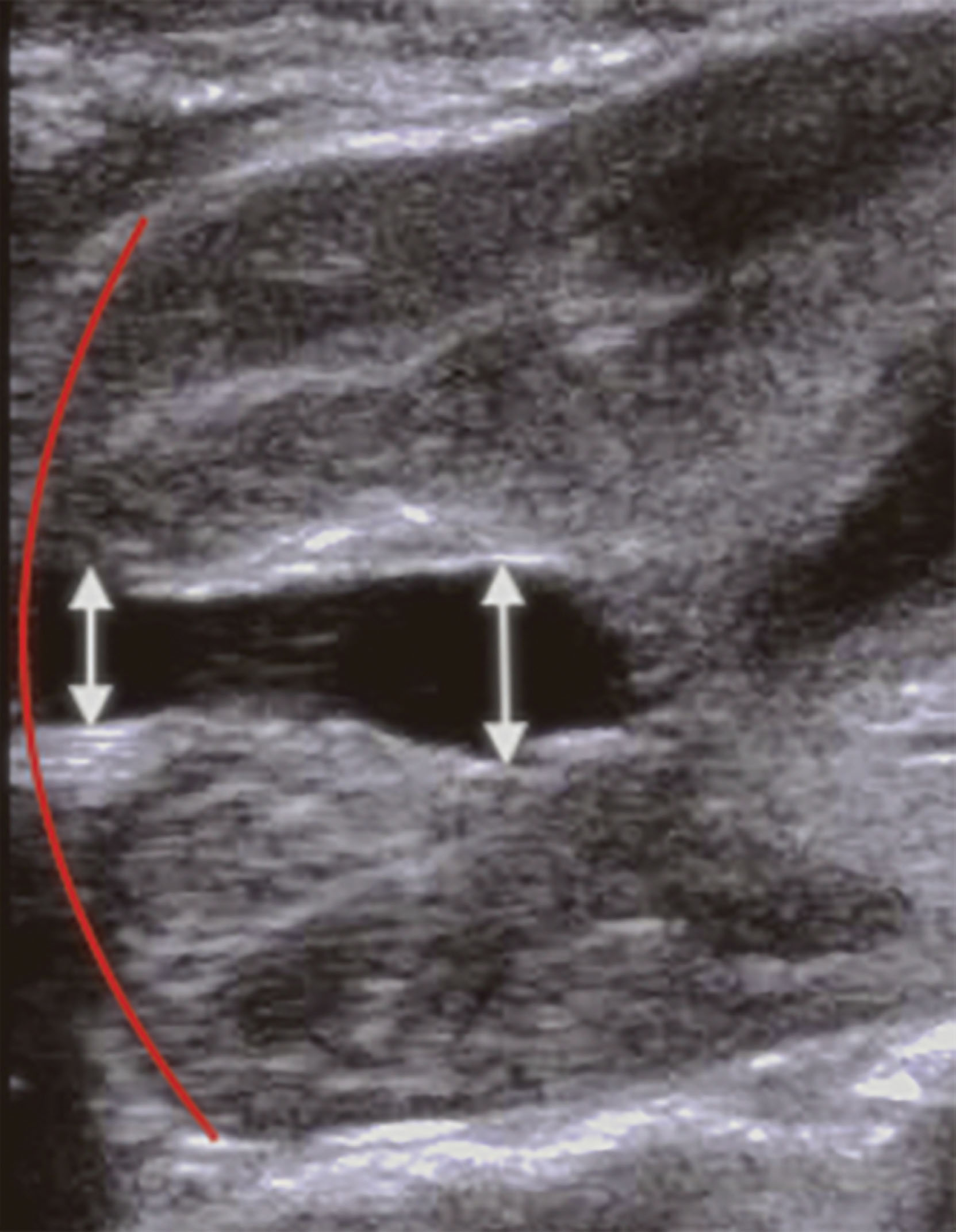
Involvement of calyceal dilation (the distinction between central and peripheral calyces is only made postnatally)
Renal parenchyma thickness
Appearance of the renal parenchyma
Abnormalities of the bladder
Abnormalities of the ureter
| Normal | UTD P1 | UTD P2 | UTD P3 | |
|---|---|---|---|---|
| APRPD (anterior-posterior renal pelvic diameter) | <10 mm | ≥10–15 mm | ≥15 mm | ≥10 mm |
| Dilation of the calyces | None | Central only | Peripheral | N/A |
| Parenchymal thickness | N | N | N | A |
| Parenchymal appearance | N | N | N | A |
| Ureters | N | N | A | N/A |
| Bladder | N | N | N | A |
Although this system has slowly been adopted, the extent of this adoption remains unclear. However, in a small survey via the SFU, roughly 70% of pediatric urologists were still using the SFU grading system and 19% were now using the UTD system. However, 54% of the respondents stated they preferred the SFU system for a unified classification, while 34% favored the UTD system. It is unknown how much these preferences extend to pediatric radiology, whose societies proposed the UTD classification. Furthermore, inter-rater reliability was substantial with the UTD system and moderate with the SFU system. Another small study to compare the fetal renal dilation between the SFU and UTD studies also found a higher inter-rater reliability among the UTD classification system.
More research and validity of the UTD system will likely be necessary for furthering its adoption. Regardless of the system utilized, the features presented in this classification are reported and may be used to describe UTD and the various causes listed below.
Vesicoureteral reflux (VUR) is a common nonobstructive cause of UTD and is indicated in up to 33% of prenatally diagnosed UTD. VUR is the abnormal refluxing of urine from the urinary bladder through the ureters back into the kidney.
It is often treated conservatively because it is nonobstructive. In severe cases, a shunt from the kidney to the bladder may need to be placed. Many cases, often males, and an appreciable number of moderate UTDs, resolve on their own within the first 2 years of life. Unilateral or bilateral UTD may occur, and different sides may have different reflux levels (i.e., severity of UTD). Although ultrasound can often detect the higher levels of VUR, it may be helpful to detect lower grades by using both pre-void and post-void renal imaging. Additionally, waiting 48 hours to perform a postnatal ultrasound is recommended, as low urine output is typical at birth. It is definitively diagnosed by a voiding cystourethrogram or ceVUS.
Sonographic findings for VUR are often nonspecific and may or may not include UTD, renal pelvic or ureteral wall thickening (also termed urothelial or uroepithelial thickening, which is due to irritation of the epithelial lining), intermittent dilation of the collecting system, or displaced ureteral jet in the bladder.
Dilation of the ureter may be seen in vesicoureteral reflux and may also be caused by nonobstructive primary megaureter or obstruction (causing megaureter). Nonobstructive primary megaureter implies a congenitally expanded or widened ureter, which does not function normally, resulting in reflux from the bladder back into the affected ureter.
In obstructive primary megaureter, the ureter may be congenitally constricted anywhere along its course or, most commonly, at the ureterovesical junction causing renal dilation. In secondary megaureter, the ureter is obstructed in the more distal urinary tract, bladder, or urethra. Also, a secondary process such as abscess, previous surgery (e.g., for appendicitis), lymphoma, and urolithiasis may cause obstruction to the ureter. Ureteral atresia or an ectopic ureter may be the underlying cause as well.
With megaureter, sonography shows UTD involving the ureters and the kidneys. A small segment of the distal ureter is seen behind the bladder. The best way to demonstrate the dilated ureters at the vesicoureteral (bladder/ureter) junction is in the longitudinal scan plane ( Fig. 26.10 ).

The increased peristalsis in the ureter distal to the obstruction may be seen with sonography as the probe is held over the dilated ureter, and the sonographer watches for the peristaltic movement. M-mode may enable a semi-quantified assessment of this ureteral peristalsis. A diminished ureteral inflow jet may be seen at the lower margin of the bladder with color Doppler on the side of the obstruction.
Ureteropelvic junction (UPJ) obstruction is the most common type of obstruction causing UTD of the upper urinary tract and occurs in 1 in 2000 children with a male prevalence (3:1), accounting for about 10% of prenatally diagnosed UTD. It most often results from intrinsic narrowing or extrinsic vascular compression at the level of the ureteropelvic junction. The obstruction produces proximal dilation of the collecting system, and the distal ureter is often normal in size. There is an increased incidence of abnormalities of the contralateral kidney, such as multicystic dysplastic kidney or vesicoureteral reflux.
Become a Clinical Tree membership for Full access and enjoy Unlimited articles
If you are a member. Log in here